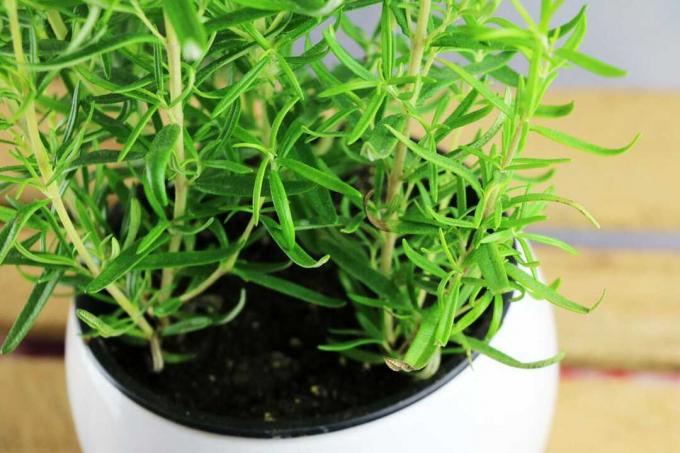
Table of Contents
- location
- floor
- Rosemary in the pot
- frequently asked Questions
rosemary (Rosmarinus officinalis) is an intensely aromatic culinary herb. As such, it can be cultivated well in the garden or in pots. Read how much light the rosemary needs and in which location it feels particularly comfortable.
In a nutshell
- natural location on barren, sunny rocky slopes on the Mediterranean Sea
- needs a lot of sun and warmth
- only full sun place with midday sun
- humus, loose and well-drained soil ideal
- Herb soil or potting soil mixed with sand for pot rosemary
location
In nature, the herb grows on barren rocky slopes that are permanently exposed to the sun in the Mediterranean region. As in its natural location, it is best to plant rosemary in a place that
- lying in full sun
- is not shaded even at lunchtime
- is as warm as possible
In contrast to many other garden plants, the subshrub thrives best in a blazingly sunny, hot spot - do not shade it over the midday hours either. On the other hand, partially shaded or light-shaded locations are unsuitable, as these are too dark for the light and warmth-hungry plant. The best place in the garden is almost always in front of a brightly painted south wall.

Tip: Rosemary copes very well with drought, but you still shouldn't let the root ball dry out completely - this could result in a loss of flavor. Water regularly, but little, and with water that is as lukewarm as possible.
floor
A floor that
- rich in humus
- loose and permeable
- as well as dry
is. You can thin out heavy garden soil with sand before planting, and a drainage made of gravel or similar material should be created. The herb does not tolerate waterlogging, which is why rain and irrigation water run off quickly. should seep in. A spot in naturally poor, sandy garden soil or in the garden is therefore very suitable Rock garden.

Tip: If you have a Herb spiral plant, it is best to put the rosemary bush right at the top. In the lower areas come herbs like parsley and chives, which like it a little darker and more humid.
Rosemary in the pot
Planted rosemary does not differ from pot rosemary in terms of its preference for a fully sunny location and as much light and warmth as possible. In any case, you'd better keep the plant in containers, at least if you have them overwinter want. If possible, choose a plant pot made of natural material (e.g. B. Clay), as this creates a better microclimate. Since air can be exchanged through the pores, the roots are adequately ventilated and mold is less likely to develop. In addition, the plant pot should have a drainage hole in the bottom so that excess water can drain away. Place a pottery shard over this hole to prevent it from clogging. A suitable substrate is humus-rich potting soil, leaned with a little sand or expanded clay, or special herb soil.

Tip: You don't have to buy potting soil, you can make it yourself. To do this, mix sifted earth with fresh Molehills with ripe compost and some sand.
frequently asked Questions
It is best to plant a Mediterranean herb bed in a sunny and warm place, where all plants have the same requirements in terms of location, soil and care. Sage (Salvia officinalis) and thyme (Thymus vulgaris) especially fit in here. Thanks to the wide variety of varieties, you can use variegated sage varieties or scented thyme (e.g. B. Lemon or golden thyme) variety. Lavender (Lavandula), oregano (Origanum vulgare), wormwood (Artemisia absinthium) and hyssop (Hyssopus officinalis) harmonize perfectly with rosemary bushes.
Rosemary does not need too much care, and you should also be restrained when it comes to fertilization. Put potted plants in fresh, humus-rich substrate in spring and fertilize them again with an organic fertilizer in June. Nettle manure, for example, is suitable here, but well-ripened compost also provides the plants with all the important nutrients. Nitrogen-rich fertilizers (e.g. B. Damn, Horn shavings), however, should not be administered.
As a Mediterranean plant, Rosmarinus officinalis needs a lot of warmth and is therefore quite sensitive to frosty temperatures. For a short time, many varieties can tolerate frost up to approx. 5 to 10 degrees Celsius, depending on the variety and provided the root ball is not too wet. Nevertheless, in our latitudes, the herbs should not overwinter outdoors, but rather spend the winter in a cool and bright place in the house. Temperatures of up to ten degrees Celsius are ideal.
